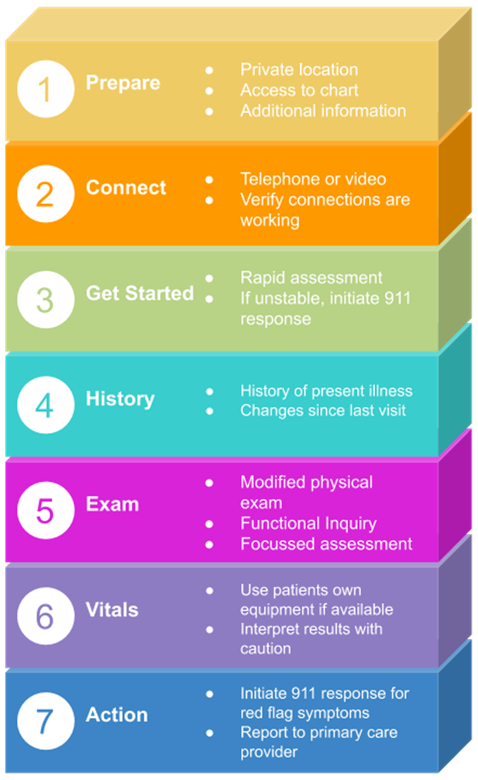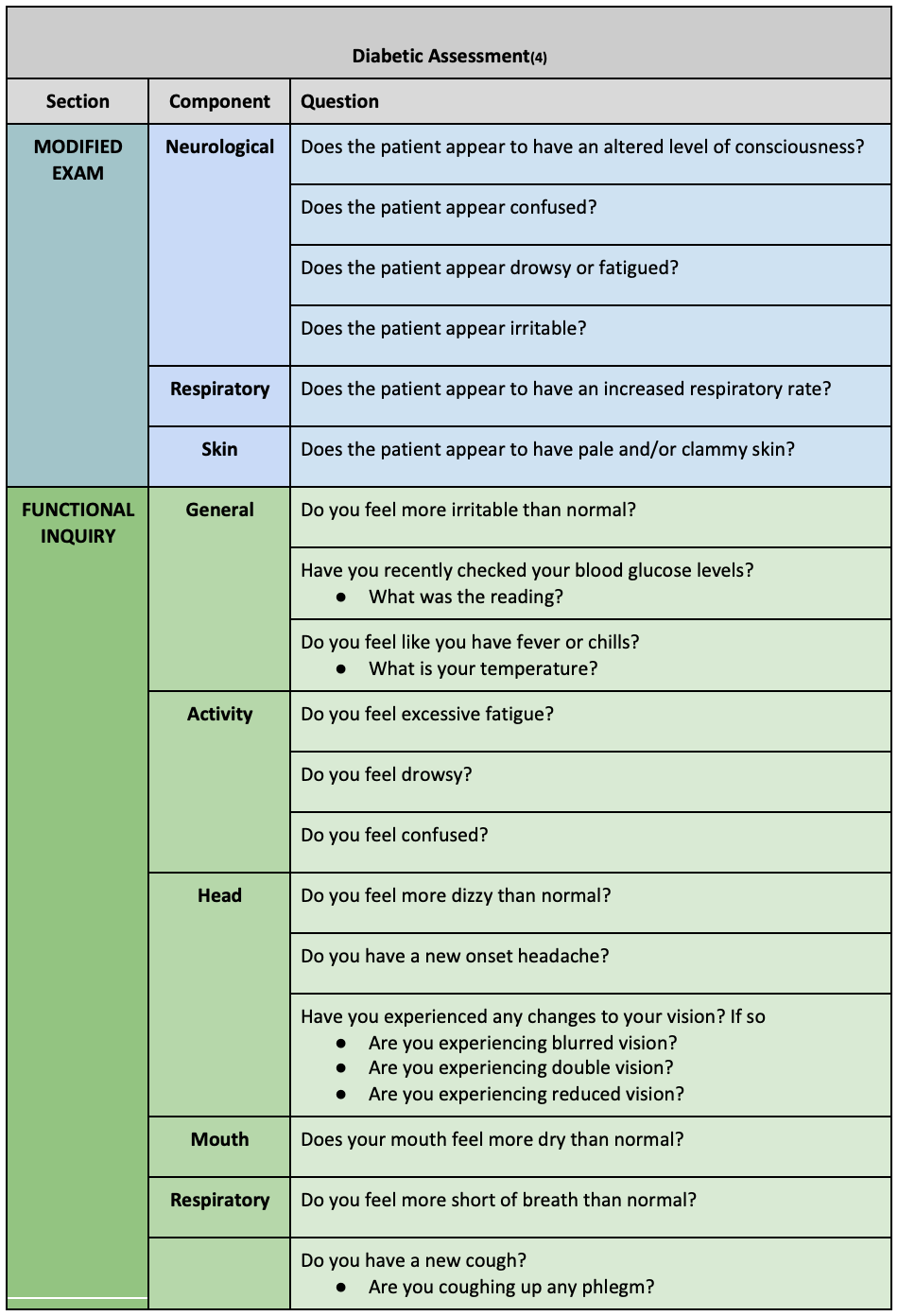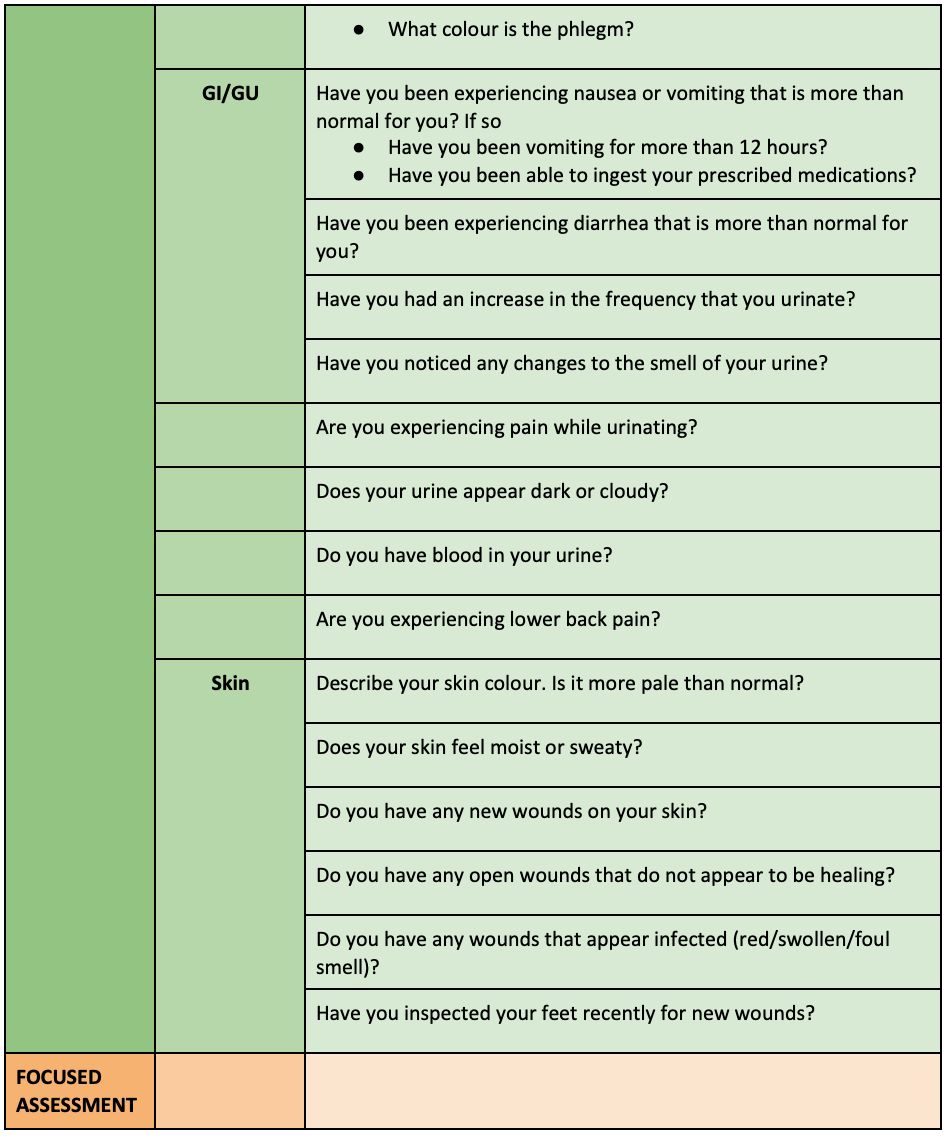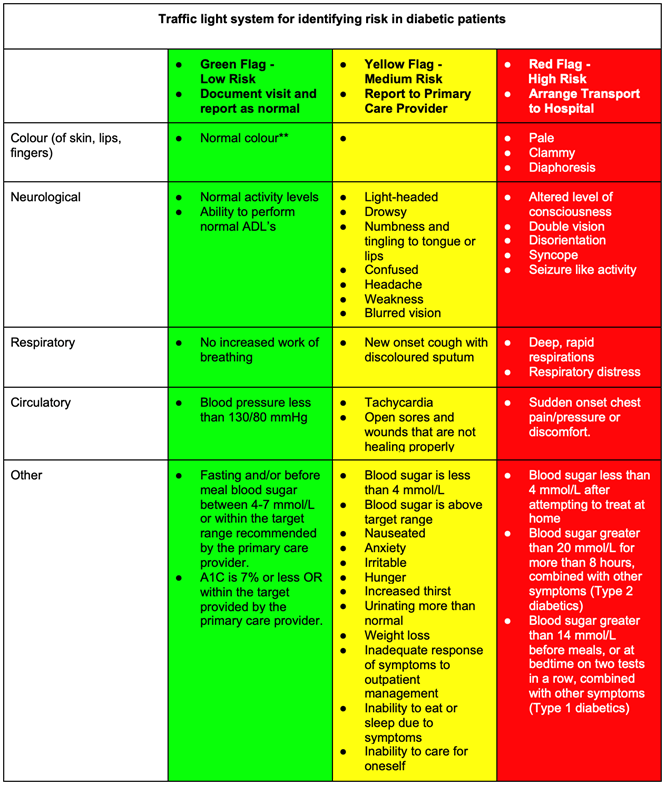Confirmation
Virtual Diabetic Assessments
CPG: Virtual Health
Created: April 15, 2020
Updated: --
Author: Chris Michel
Introduction:
Virtual care is healthcare at a distance and many assessments need to be adapted in the absence of a face-to-face interaction1. Clinical assessments involve the use of tools and instruments which are not available in virtual healthcare settings. Information will need to be gathered in other ways, such as listening to the patient’s cough, or the audible presence of adverse breath sounds, such as wheezing. As with conventional assessments, determine if the patient is experiencing a particular problem and focus on that area first. If no particular problem is present, complete a generalized assessment of the relevant system2.
Essentials3:
- Set-up: Before initiating a virtual visit, make sure you are set up properly, have access to the patient chart, and any additional information that may be required.
- Connect: Determine the most appropriate method for communicating with the patient (either phone or video chat). Confirm that your audio and video connections are working properly.
- Get started: Once you begin the visit, perform a rapid assessment to determine if any immediate interventions are needed. For example, does the patient appear very sick or are they too short of breath to speak? If so, go directly to asking key clinical questions. If no immediate interventions are required, establish what the patient hopes to gain from the visit (i.e., clinical assessment, referral, reassurance).
- History: Ask questions to determine a history of the present illness.
- Examination: Perform a modified physical exam and ask functional inquiry questions.
- Vitals: The patient may be able to take their own measurements if they have access to vitals equipment at home (i.e., blood pressure monitor, pulse oximeter, scale). Interpret results with caution and use them to support findings in the context of your wider assessment.
- Decision and action: Based on your findings, decide if you should report to the patient's most responsible provider, or if the patient requires immediate conveyance to hospital.

Assessment Overview:
- It has been found that, for people with diabetes, virtual healthcare reduces the onset of macro and micro complications and subsequent hospitalizations. The purpose of contacting people is to reinforce their prescribed treatment plan. In general, the major categories when providing care are:
- Self-monitoring
- Medications
- Nutritional intake
- Activity/exercise
- Diagnostic evaluation
- Preventive actions2
Virtual Assessments:


Risk Identification:

4,5,6,7,8
* If able to measure using the patient's supplied equipment
** If able to assess using video conferencing tools
Decision and Action:
- All patients with worsening diabetic symptoms (yellow) should be referred to their primary care provider for assessment.
- If the paramedic does not have an existing history with the patient, they should strongly consider emergency conveyance to hospital for any patients experiencing yellow flag symptoms.
- Patients with red flag symptoms should be conveyed to the emergency department for assessment and treatment.
Additional Treatment Information:
- Many patients living with diabetes utilize a 'Diabetes Zones' plan, which is provided by their primary care provider. Patients should be encouraged to follow their action plan when and if they become symptomatic.
References & Further Reading:
- Telemedicine; Researchers from University of Arizona Detail New Studies and Findings in the Area of Telemedicine (Clinical Examination Component of Telemedicine, Telehealth, mHealth, and Connected Health Medical Practices). Medical Devices & Surgical Technology Week [Internet]. 2018 Jun 10;140. Available from: https://ezw.lib.bcit.ca/login?url=https://search.proquest.com/docview/2047463316?accountid=26389
- Martich D. Telehealth Nursing : Tools and Strategies for Optimal Patient Care [Internet]. New York, NY: Springer Publishing Company; 2017. Available from: http://search.ebscohost.com/login.aspx?direct=true&AuthType=ip,sso&db=nlebk&AN=1442257&custid=s5672081
- Greenhalgh T, Koh GCH, Car J. Covid-19: A remote assessment in primary care. BMJ [Internet]. 2020 Mar 25;368:m1182. Available from: http://www.bmj.com/content/368/bmj.m1182.abstract
- Briggs J. Telephone Triage Protocols for Nursing [Internet]. Vol. 5th ed. Philadelphia: Wolters Kluwer Health; 2015. Available from: http://libproxy.jibc.ca:2048/login?url=https://search.ebscohost.com/login.aspx?direct=true&db=e000xna&AN=1473165&site=ehost-live&scope=site
- Willis S, Dalrymple R. Fundamentals of Paramedic Practice : A Systems Approach [Internet]. Hoboken, NJ: Wiley-Blackwell; 2020. (Fundamentals; vol. Second edition). Available from: http://libproxy.jibc.ca:2048/login?url=https://search.ebscohost.com/login.aspx?direct=true&db=nlebk&AN=2240099&site=ehost-live&scope=site
- Justin L. Kaplan and Robert S. Porter, editor. Merck Manual Professional Version [Internet]. Whitehouse Station, NJ: Merck Sharp & Dohme Corp., A Subsidiary of Merck & Co.,Inc.; 2020. Available from: http://online.statref.com/document/MgMqo5q0ZcWCLC6nQYXHuw‼
- Diabetes Zones [Internet]. Island Health; 2018. Available from: https://www.islandhealth.ca/sites/default/files/2019-02/Diabetes_Zones.pdf
- Clinical Practice Guidelines 2018 [Internet]. County of Renfrew Paramedic Services; 2018 [cited 2020 Apr 14]. Available from: https://www.renfrewparamedics.ca/wp-content/uploads/2018/04/Clinical-Practice-Guidelines-2018.pdf